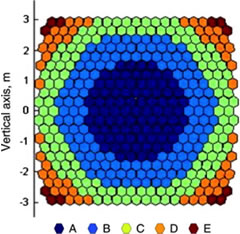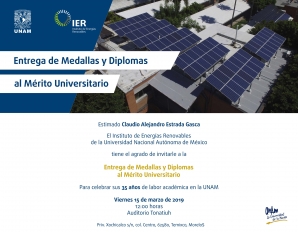Mostrando artículos por etiqueta: 2012 publication
Assessment of a polymeric reflective coating for high concentration point focus applications
D. Riveros-Rosas, R. Castrejón-García, C. A. Arancibia-Bulnes, C. A. Pérez-Rábago, and C. A. Estrada-Gasca
Abstract
20 A methodology for the evaluation of the specularity error of a polymeric film optical coating is presented. The methodology is based on the comparison of images from the sun produced by two high quality spherical mirrors, one covered with a highly specular evaporated aluminum film, and the second one with the polymeric film under study. This film is a commercial product known as Reflectech®. To determine the specularity error, both images are reproduced by means of ray tracing optical simulations. Those simulations use the angular brightness distribution from the sun as input, which were recorded by means of a specially developed solar scope. Significant differences are obtained between images of the sun generated by both mirrors. However, the specularity error of the coating under consideration is found to be just 0.71 mrad. This error is quite small making the polymeric coating highly appropriate for point focus concentration systems. This is illustrated by calculations for a parabolic dish concentrator.
Assessment of a polymeric reflective coating for high concentration point focus applications
Optimal performance assessment for a photo-Fenton degradation pilot plant driven by solar energy using artificial neural networks
A. Bassam, I. Salgado-Tránsito, I. Oller, E. Santoyo, A.E. Jiménez, J.A. Hernandez and A. Zapata.
Abstract
Artificial neural networks (ANN) were proposed as a multivariate experimental design tool for monitoring a photo-Fenton treatment of wastewaters containing a synthetic mixture of pesticides. ANN and Nelder-Mead simplex methods were used to find out the optimum operating parameters of a photo-Fenton pilot plant. ANN was developed to predict the most important operating parameters (e.g., the total organic carbon and the initial mineralization kinetic rate constants of the reactions), which determine the photo-catalytic degradation efficiency in photo-Fenton processes. Experimental measurements of temperature, pH, hydrogen peroxide (H2O2) consumption, initial concentration of Fe2+, and the AE were used as input data for the ANN learning. A feed-forward with one hidden layer, a Levenberg–Marquardt learning algorithm, a hyperbolic tangent sigmoidal transfer function and a linear transfer function were used to develop the ANN model. The best fitting of the training database was obtained with an ANN architecture constituted by seven neurons in the hidden layer. The simulated results were validated with experimental measurements, showing an acceptable agreement (R2 > 0.99). The ANN was subsequently coupled with a Nelder–Mead simplex method to obtain the optimum operating parameters of the photo-Fenton pilot plant. The H2O2 consumption was used as key variable for evaluating the optimization procedure. Errors less than 1% between simulated and experimental data were found. The obtained results showed that the use of ANN provides an excellent predictive performance tool with the additional capability to assess the influence of each operating parameter on the removal process of water pollutants.
Photon Absorption in a Hybrid Slurry Photocatalytic Reactor: Assessment of Differential Approximations
S. L. Orozco, H. I. Villafán-Vidales, C. A. Arancibia-Bulnes
Abstract
Radiative transfer inside a slurry photocatalytic reactor with hybrid illumination from both solar radiation and lamps is examined. The local volumetric rate of photon absorption is evaluated. For this purpose, the P1 and the modified differential approximations (MDAs) are used, and results compared to a solution by the Monte Carlo method. It is found that significant differences may arise between the predictions of the above approximations and the exact results provided by the Monte Carlo simulations. The P1 approximation is very inaccurate near to the radiation entrance for the partially collimated solar radiation, although it improves, as optical depth increases. As expected, the MDA improves the results near to the boundary. Surprisingly, it turns out to be much worse than the P1 approximation at medium and large optical depths. In the case of lamp irradiation, the behavior of the MDA is the opposite; it works better at small optical depths.
Assesment of a Polymeric Reflective Coating for High Concentration Point Focus Applications
D. Riveros-Rosas, R. Castrejón-García, C. A. Arancibia-Bulnes, C. A. Pérez-Rábago, C. A. Estrada-Gasca
Abstract

A methodology for the evaluation of the specularity error of a polymeric filmoptical coating is presented. The methodology is based on the comparison of images from the sun produced by two high quality spherical mirrors, one covered with a highly specular evaporated aluminumfilm, and the second one with the polymeric film under study. This film is a commercial product known as Reflectech®. To determine the specularity error, both images are reproduced by means of ray tracing optical simulations. Those simulations use the angular brightness distribution from the sun as input, which were recorded by means of a specially developed solar scope. Significant differences are obtained between images of the sun generated by both mirrors. However, the specularity error of the coating under consideration is found to be just 0.71 mrad. This error is quite small making the polymeric coating highly appropriate for point focus concentration systems. This is illustrated by calculations for a parabolic dish concentrator.
Assesment of a Polymeric Reflective Coating for High Concentration Point Focus Applications
Radiative heat transfer analysis of a directly irradiated cavity-type solar thermochemical reactor by Monte-Carlo ray tracing
H.I., Villafán-Vidales, Abanades, S., Arancibia-Bulnes, C.A., Riveros-Rosas, D., Romero-Paredes, H., Espinosa-Paredes, G., Estrada, C.A.
Abstract
Radiative heat transfer in a 1 kW cavity-type solar reactor devoted to the thermal reduction of compressed ZnO and SnO2 powders is analyzed by a Monte Carlo ray tracing simulation. The developed model takes into account the radiative properties of the reactant particles and of the ceramic cavity walls, as well as the angular intensity distribution of the incoming concentrated solar irradiation. The model also includes the conduction heat losses through the lateral walls and the energy consumed by the endothermic chemical reaction. It is used to predict the temperature and the absorbed flux density profiles on the inner cavity walls for different main features of the reactor, concerning the dimensions of the cavity and the type of reactant. Results show that the absorbed flux density profile and the theoretical thermochemical efficiency change with the cavity aspect ratio and with the oxide reactant. The cavity with an aspect ratio of 3 and a SnO2 pellet undergoing dissociation presents the highest thermochemical efficiency. Additionally, a different configuration of the reactor design is considered, which consists in implementing a layer of reactive particles on the inner lateral cavity wall. The model highlights that this type of reactor operation with a reactant layer on the lateral cavity wall results in an improved thermochemical efficiency.

